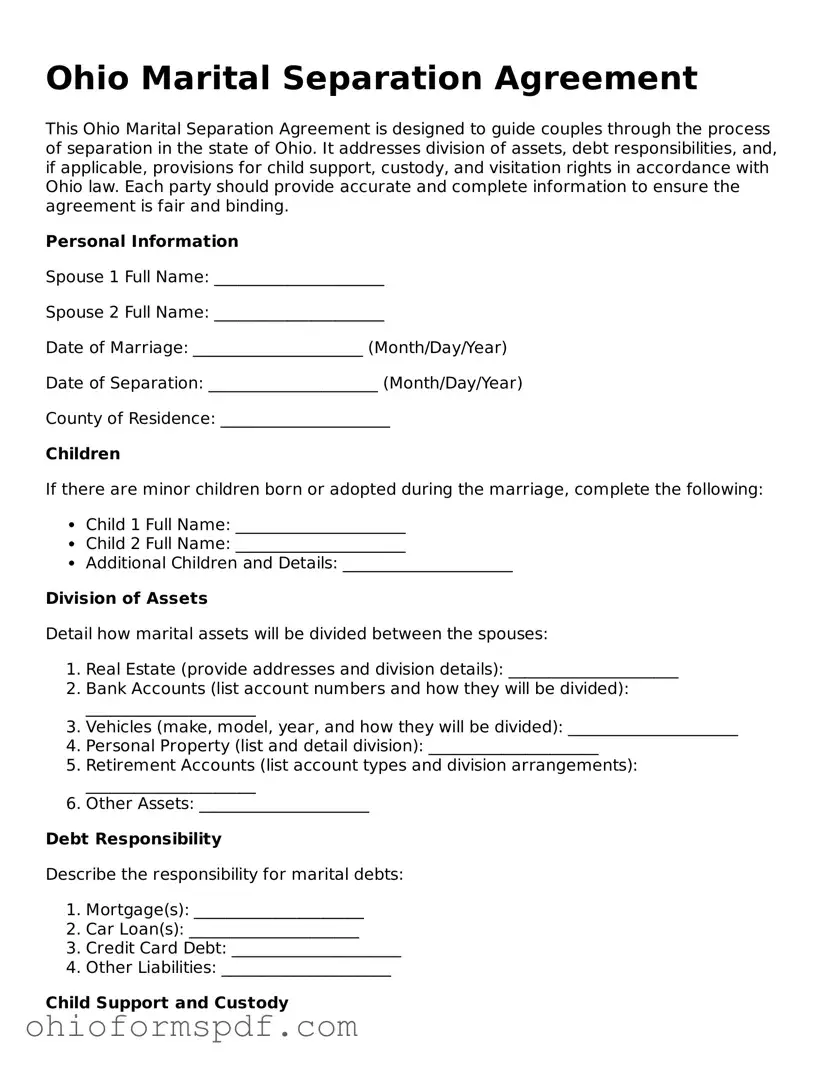Ohio Marital Separation Agreement
This Ohio Marital Separation Agreement is designed to guide couples through the process of separation in the state of Ohio. It addresses division of assets, debt responsibilities, and, if applicable, provisions for child support, custody, and visitation rights in accordance with Ohio law. Each party should provide accurate and complete information to ensure the agreement is fair and binding.
Personal Information
Spouse 1 Full Name: _____________________
Spouse 2 Full Name: _____________________
Date of Marriage: _____________________ (Month/Day/Year)
Date of Separation: _____________________ (Month/Day/Year)
County of Residence: _____________________
Children
If there are minor children born or adopted during the marriage, complete the following:
- Child 1 Full Name: _____________________
- Child 2 Full Name: _____________________
- Additional Children and Details: _____________________
Division of Assets
Detail how marital assets will be divided between the spouses:
- Real Estate (provide addresses and division details): _____________________
- Bank Accounts (list account numbers and how they will be divided): _____________________
- Vehicles (make, model, year, and how they will be divided): _____________________
- Personal Property (list and detail division): _____________________
- Retirement Accounts (list account types and division arrangements): _____________________
- Other Assets: _____________________
Debt Responsibility
Describe the responsibility for marital debts:
- Mortgage(s): _____________________
- Car Loan(s): _____________________
- Credit Card Debt: _____________________
- Other Liabilities: _____________________
Child Support and Custody
If applicable, outline the agreement on child support, custody, and visitation rights in accordance with Ohio's child support guidelines and custody laws:
- Child Support Details (amount and duration): _____________________
- Custody Arrangements: _____________________
- Visitation Schedules: _____________________
Spousal Support
Detail any agreed-upon spousal support (alimony) including amounts and duration:
Spousal Support Terms: _____________________
Miscellaneous Provisions
Include any additional terms or conditions relevant to the separation agreement:
Additional Terms: _____________________
Signatures
This agreement is voluntary and entered into by both parties with a full understanding of its implications. Each party acknowledges that they have had the opportunity to seek independent legal advice before signing.
Spouse 1 Signature: _____________________ Date: _____________________
Spouse 2 Signature: _____________________ Date: _____________________
Notary Public: _____________________ Date: _____________________
This document was acknowledged before me on this date by [insert names of spouses].
